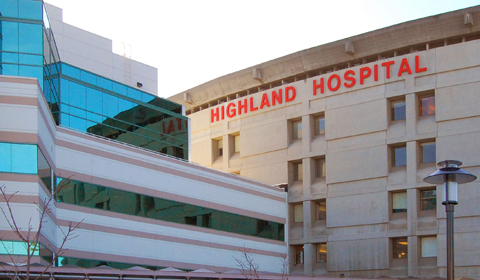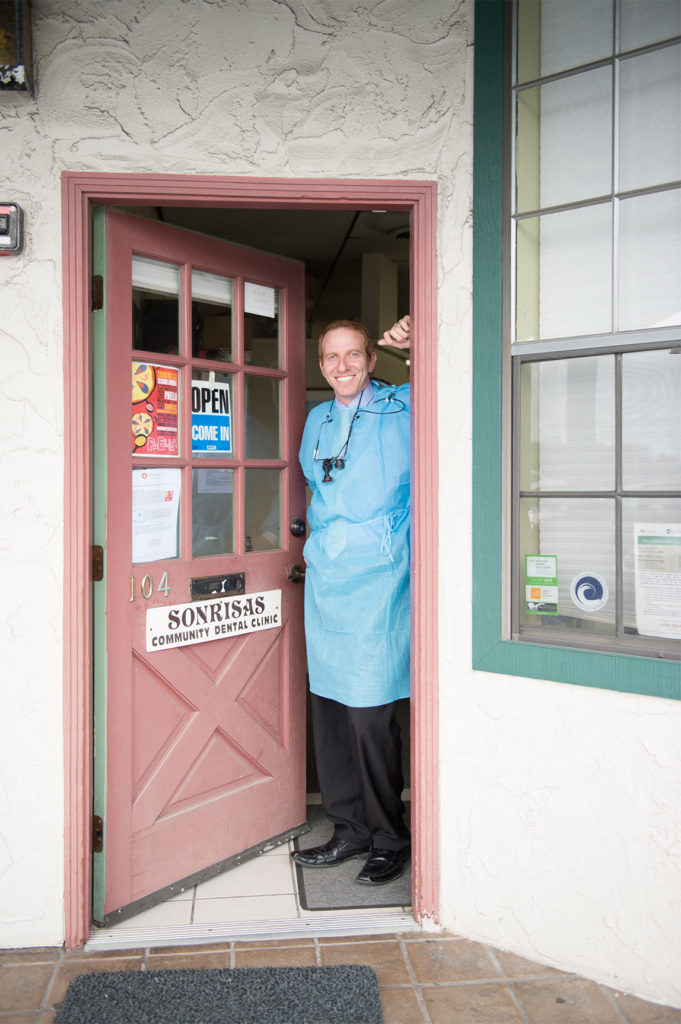By Christina Boufis
“Community involvement is a huge part of our dental school,” said Dr. Sigmund Abelson ’66, associate dean for clinical affairs. “It’s part of our mission but also part of a student’s education.” To that end, students from the Arthur A. Dugoni School of Dentistry travel to different extramural sites to provide care and serve the needs of a diverse patient population at community clinics, hospitals, senior centers and other locales.
“Not only do we want to do good things and provide dental care to the underserved,” said Abelson, “but also exposing our students to different populations is a tremendous learning opportunity. We hope that after they graduate, many of them will want to work in some of these underserved areas.”
One rotation that is mandatory for students in their second and third clinical years is to spend about a week at Highland Hospital’s Oral Surgery program in Oakland. The students gain needed hospital experience for their degree, explains Dr. A. Thomas Indresano, chair of the Dugoni School’s Department of Oral and Maxillofacial Surgery and the Dr. T. Galt and Lee DeHaven Atwood Endowed Professor, who heads the Oral and Maxillofacial Surgery residency program and student rotations at the hospital. “We let them work in the clinic to perform extractions and some minor surgery, and that adds to their experiences in the surgery clinic at school. Indeed, the patient population whom students encounter at Highland Hospital, a major regional trauma center, consists of many people who are in pain and who most likely do not have a regular dentist.”
[pullquote]The students get to observe how interdisciplinary care functions.[/pullquote]
In addition to receiving hands-on clinical training, students get experience seeing patients from the entire medical view. “In school students learn that every patient should complete a medical history and students review all of their medical conditions. But it’s really brought home when students operate on patients and are certain that these things are correct,” he added.
Though the rotation at Highland Hospital is mandatory, not every student is enthusiastic about surgery. But, according to Indresano, “you’d be surprised at how quickly they catch on. You can see a big difference after one week, and then after the second week they’re pretty comfortable. They’re less timid.”
Students also have the opportunity to participate in an extramural rotation at La Clinica de la Raza, in the Fruitvale neighborhood of Oakland, home to the city’s largest Latino population. “We are a community-based health center, so we actually provide medical, dental, optometry and mental health services,” said Dr. Ariane Terlet ’86, chief dental officer at La Clinica. About 50% of the patients are children, about 80% are Hispanic and all are low-income at 200% of the federal poverty level and below. “We have patients who have a lot of needs and a lot of decay, and our students are able to provide quite a bit of service.”
There are different student rotations at La Clinica, including removable prosthodontics and endodontics. “The students observe many different things and receive a lot of experience. And the patients are grateful to have the care.”
Rotations at La Clinica are very popular and, while they require a lot of work, they’re a win-win for everyone, according to Terlet. “I need to provide care to a large group of people, and, if I can supervise others, it gives me more hands. It’s also a great educational experience for the students, and there’s a great deal of satisfaction in watching them learn and having them be excited.” Furthermore, the student rotations serve as a “retention and recruitment tool not just for our own site, but for other community health centers that need qualified staff.”
[pullquote]Students rate their rotations at these different extramural sites quite highly.[/pullquote]
Exposing students to a different patient population and having them work at the clinic may even spark one of them to consider a career in public health, as one of Terlet’s endodontic residents is now doing. “I don’t think he ever would have considered it before coming to work for us.”
Students treat another underserved population when they rotate through On Lok Lifeways, an organization that serves seniors throughout the Bay Area. On Lok Lifeways is a Program of All-inclusive Care for the Elderly (PACE) program. Its goal is to keep seniors, who would otherwise meet the criteria to be placed in a skilled nursing facility, in their own homes.Dental students participate in a one-day rotation at either of the On Lok senior centers on Bush Street or 30th Street in San Francisco. “One of the main lessons we hope students get from the rotation is an appreciation for the interdisciplinary care that’s provided there,” said Dr. Elisa Chavez, associate professor in the Department of Dental Practice, who also directs student rotations at On Lok Lifeways.
Students have the opportunity to see multiple patients, many who have six or seven major medical conditions, and are taking several medications or have varying levels of dementia. “It’s kind of eye opening in certain respects, when you see all the complexities that can impact dental care,” explained Chavez. “The seniors are a very different population from what the students would see in the dental school’s Main Clinic. The students observe how interdisciplinary care functions and why it’s very important when you’re dealing with frail elders. And they are able to provide a variety of services.”
Extramural rotations have been part of the dental school’s educational program for the last few decades. Dr. Dennis Kalebjian ’78 was one of the first students to do a rotation in Fresno at the Valley Medical Center, which has now merged into the Community Regional Medical Center, a Level I trauma center in the Central Valley. At this rotation, students are exposed to some of the most challenging cases, particularly very young children and patients with special needs or who have oral and facial trauma.
“The main things students learn from an extramural rotation is the basic concept of hospital dentistry, being on call after hours with the residents, making in-patient hospital visits when a consult is required and actually operating on out-patient hospital cases under general anesthesia, particularly on young patients with special needs,” said Kalebjian.
After Kalebjian’s experience with the Fresno rotation as an undergraduate, he got hooked. “I became a resident, and later an attending faculty member, and remain here to this day. I’m not alone in that. There are a couple of people who have followed the same route.”
Dr. Torrey Rothstein ’05, director at the Sonrisas Community Dental Center in San Mateo, another extramural rotation site, also felt the pull to help an underserved community. “An opportunity arose to work at Sonrisas a year after I graduated. At the time I was working part-time as an associate dentist in a private practice. There was such a contrast working at a safety net clinic compared to the private office, a contrast that pulled me towards helping the underserved in our community and has kept me here for almost 10 years.
The patient population at Sonrisas is low-income, below 250% of the federal poverty level and without private insurance, according to Rothstein who oversees student rotations at Sonrisas, along with Dr. Brian Sheppard ’10. “It’s a smaller clinic, and the students get a lot of very good experience—one-on-one coaching and instruction and the opportunity to receive good feedback,” said Rothstein. “They have new clinical experiences that will benefit them throughout their careers. We’ve heard students enjoy coming here. I’m not sure if it’s because we’re close to the beach or if it’s the clinical experience.”
Joking aside, students rate their rotations at these different extramural sites quite highly. “When we do exit interviews, rotations always come back as one of the best experiences they’ve had in dental school,” said Abelson. “Our students find it valuable. We treat the population that’s in great need of dental care and, at the same time, we’re providing this tremendous educational experience for our students.”
Christina Boufis, PhD, is a health and medical writer from the East Bay.

On Lok, San Francisco, CA 
Highland Hospital, Oakland, CA 
Sonrisas, Half Moon Bay, CA